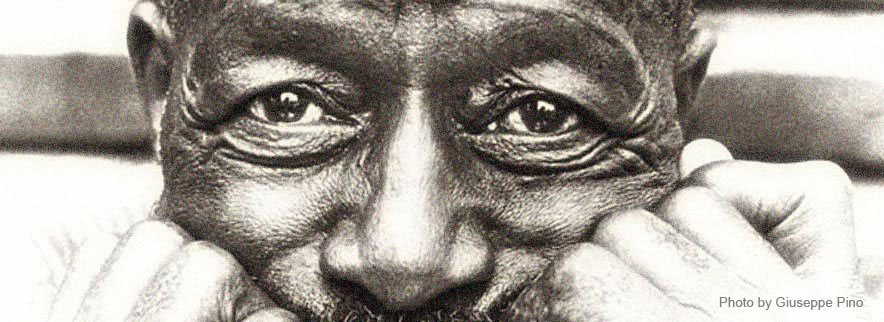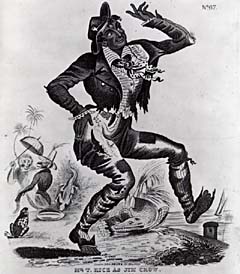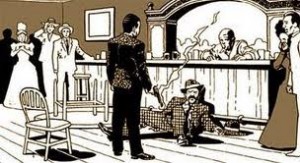Each culture has its myths and folk heroes. They are an expression of the social and economic systems and their evolution in which they are given shape. In Western Europe for instance we are familiar with the good bandit Robin Hood who stole from the poor to give it to the rich. A similar figure was popular in north America where he was called Jesse James. These folkloric figures imprinted in the popular consciousness are very often a way by which a particular part of the population deals with its position in society. John Henry, another heroic figure in the United States, was for instance the idol of the rail road gangs who were faced by an increasing mechanization of their work : John Henry was capable with his mere hands to beat the steam powered hammer in the construction of the railway tracks in the 19th century.
In American culture, and especially in African American culture, Stagger Lee is without any doubt the most famous and well known hero. In this post I argue that this mythical figure helped in the survival of the Jim Crow system, where I use the word ‘survival’ in two meanings. First, the myth was very instrumental for the black population in the 19th and 20th century to cope with all of the cruelties imposed upon it by the hypocritical principle of “segregated but equal“. Secondly, the very existence of the story aided the system to stay upright : the admiration for Stagger Lee by the black population served as a valve for the pressure that could have gone out of proportion following the systemic oppression by a system that put more value on a mule than on a Negro. Against the brutality of the white society, the African American population could find some consolation in its secret admiration for a man who dared to challenge the oppressor. As a small reminder : Jim Crow refers to a caricature figure created in the black face theatre in the first half of the 19th century, a name which by his pejorative meaning, was used to denominate the legal construction in which blacks were segregated from the white population in all aspects of public life after they had been freed as slaves in the wake of the Civil War. This legal construction existed until the second half of the 20th century and was only changed, bit by bit, from the civil rights movement as of the 1950s.
Let me make myself clear in what follows.
There are different dimensions to the Stagger Lee theme. There is the myth and the form it has taken in oral tale telling, ballads, poems, musicals,.. There are are also the facts, or what we know of those facts.
For the latter, let us quote the story from the journal the St. Louis Daily Globe-Democrat of 28 December 1895 :
Shot in Curtis’s Place :
William Lyons, 25, colored, a levee hand, living at 1410 Morgan Street, was shot in the abdomen yesterday evening at 10 o’clock in the saloon of Bill Curtis, at Eleventh and Morgan Streets. by Lee Sheldon, also colored. Both parties, it seems, had been drinking and were feeling in exuberant spirits. Lyons and Sheldon were friends and were talking together. The discussion drifted to politics and an argument was started, the conclusion of which was that Lyons snatched Sheldon’s hat from his head. The latter indignantly demanded its return. Lyons refused, and Sheldon drew his revolver and shot Lyons in the abdomen. Lyons was taken to the Dispensary, where his wounds were pronounced serious. He was removed to the city hospital. At the time of the shooting, the saloon was crowded with Negroes. Sheldon is a carriage driver and lives at North Twelfth Street. When his victim fell to the floor Sheldon took his hat from the hand of the wounded man and coolly walked away. He was subsequently arrested and locked up at the Chestnut Street Station. Sheldon is also known as “Stag” Lee.
To summarize, a discussion between two men (a discussion which was probably also of a political nature since Stagger Lee was democrat and Billy Lyons was a republican) went out of control after heavy drinking and Stagger Lee shot Billy Lyons/Billy DeLyon without any mercy. Both were black men. Billy Lyons died from the inflicted wounds, and Lee was set to prison for his killing. He was finally convicted, served time, and died in the nineteen-tens.
The story happened in 1895, but there are serious indications that the myth goes back much earlier and that the nickname “Stag” came from this myth. As said above, the story has been subject not only of traditional tale telling, but also of poems, novels, graphic novels and musicals. Based on her Ph.D. dissertation, Cecil Brown published a book on the story in 2003 at the Harvard University Press : “Stagolee shot Billy”. James P. Hauser has written a great number of essays on the subject which are gathered on the website “The Stagger Lee Files”. As the topic of ballads and songs, the count is almost endless, in all different kind of genres : ragtime, Broadway, jazz, honky tonk, country, 50s Rock and Roll, ska, folk, surf, 70s punk, heavy metal, Hawaiian, 90s punk and rap. It has been or it is on the repertoire of a.o. James Brown, Neil Diamond, The Clash, Bob Dylan, Fats Domino, Duke Ellington, The Grateful Dead, Ike & Tina Turner, Beck, Nick Cave and Elvis Presley. Some enthusiasts have put together a list of more than 400 versions of the song. You can find a nice historic overview here. In very recent years, the hard core metal band “Modern Life is War”, has again put forth the theme on their 2007 album “Midnight in America”, though in this version the fight was about a girl and sharing the bed with her.
As for its role in the blues, well, one can say that Stagger Lee is one of the core songs of the genre that runs like a thread throughout its whole history, though some will contradict me and say that Stagger Lee is in fact not a blues ballad. Anyhow, Stagger Lee made his big entrance in the ballad form through the door of the blues. In 1923 the Fred Waring’s Pennsylvanians scored a hit with “Stack O’Lee Blues” and in 1924 the first recordings with lyrics by a black artist comes from the later famous pianist woman Lovie Austin singing “Skeeg-a-Lee Blues”. Ma Rainey records her version in 1925. The great break through however takes place with the version in 1928 by Mississippi John Hurt who brings a plaintive version, accompanied with his usual very subtle guitar playing. His version is considered as the classic start of the Stagger Lee story in blues and in the history of music, though we may not forget the 1927 version “Billy Lyon’s & Stack-O-Lee” by Furry Lewis (it was part of his first recording work for the Vocalion label in Chicago).
There are various elements in the story as it has been told over more than a century that are crucial to its understanding :
– Stag Lee acted violently;
– Stag Lee didn’t show any mercy; it was a cold blooded murder;
– Billy (or a relative) asked to spare his life;
– Stag Lee was described as a bad man;
– The Stetson hat;
– Stag Lee was tried and sentenced to death;
– Stag Lee was worse than the devil;
– The white authorities are afraid of Stag Lee and can’t catch him
– Billy cheated in gambling.
The presence and importance of each of those dimensions varies from one version to another, and blues scholars pointed out that there is a historical evolution in the lyrics and the way it has been arranged and performed. Exactly like “Sweet home Chicago” has a genealogy that reflects the social context, so does the version of Stagger Lee varies over time reflecting what went on within the global society and more particularly with the way it handled its African American population.
In his essay “Stagger Lee : the Story of the Black badman, the Stetson hat, and the Ultimate Rock and Roll Record“, Hauser (2009) develops a very interesting thesis, in comparing the version of 1928 to the one brought by Lloyd Price in 1958. During those 30 years, the song had been transformed from a cautionary blues ballad warning the black listeners to an aggressive, jubilant rock ‘n’ roll version in the late 50’s.
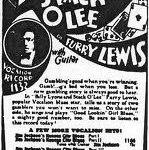
Mississippi John Hurt characterizes Stagger Lee as a cruel and a ruthless killer. The violent act is well underlined. The warning message can be understood in two different ways : on the one hand, people were warned to stay away from Lee as he was a violent and pitiless killer; on the other hand, the message could also have been that black people had to play it cool or they could land up in jail (Greil Marcus, 1975). Stagger Lee conveyed the message that one should not let the white man’s cruel system turn the black population into a bitter and angry people.
After all, when you see further than the story, one sees the portrait of a man who was not prepared to let him overrun by another. He stood up, took a gun and shot the other one. Why did he shoot? Sure, they had been drinking, but it was more than a fight which got out of hand because of too much liquor.
A first element was the fact that Billy Lyons cheated in gambling. This could hardly be accepted. White law was prepared to close an eye on the gambling by the blacks, but the latter had to take care that everything went without too much of a conflict as this would attract the white man’s attention. Cheating could endanger the taciturn acceptance of black gambling. In this perspective, the story on Stagger Lee resembles very much the tales of the bad men that are present in African tribes : cheating was seen as a potential danger to a balanced social structure and had to be punished. In this approach, Billy Lyons deserved to be shot : he earned it. The shooting was fully justified.
A second element that has received attention in the tale is the fear that Stagger Lee provoked within society. In the earlier popular versions, even the sheriff and his deputies feared the man that much that they didn’t even dare to chase him. In some versions, he was caught and imprisoned, but when he went to hell, he met the devil and took over the devil’s kingdom to his own profit. He became the devil himself.
In the earlier versions, the first two elements dominated the story. Stagger Lee was depicted and admired as a man who dared to defy the white man’s law system; and what is more : the white man didn’t even dare to challenge Stagger Lee. Haymes quotes versions where Billy Lyons is sometimes portrayed as a white policeman.
An implicit element in this is also the fact that Stagger Lee didn’t show the slightest regret over his act. It is crucial here to know that under the Jim Crow law, when a black man was sentenced to death, he was obliged to plead guilty and show regret over his deed (or supposed deed). By showing regret, the sentenced man accepted the punishment and in doing so also confirmed the whole system that allowed such sentences to be expressed. Stagger Lee defied this : he showed no regret whatsoever.
Can you feel how much the black population must have (secretly) admired this man for defying the system? They envied him. At the same time however, Stagger Lee didn’t aim to destroy the system, it was only challenged, he didn’t want to break it apart. At the end of the day, it proved too strong a system, since he was convicted and put into jail. The story didn’t end in glamour. Thus on the one hand, it gave the black population a hero to warship, it served as a kind of drug that would take a man’s mind off for a minute from the hardships of daily lives that was formed by the humiliations and the sheer violation of even the basic human rights. It helped to make a system bearable in which a man could be lynched for just looking at a white woman, or even forgetting to say ‘Mister’ when he was allowed to speak to a white man. Stagger Lee stood well above this system in which even the high law instances accepted that men were dragged through the streets, whipped to death, burnt and then hung on a tree as part of an entertaining act for young and old.
A third element in the story is the hat. Yes, the hat ! In general, a hat is a way to make a man taller, it gives him authority. It serves like the crown on a king’s head. When you greet somebody, it is good custom that you take your hat off.
When Billy Lyons took Stagger Lee’s hat, he took off Lee’s crown. But it was more than just a hat : it was a Stetson hat. A Stetson hat, with his broad impressive sides, symbolizes very much the white supremacy, it is the hat of the cowboy chasing without mercy the Indians. Even today, the Stetson company underlines in its advertising that the hat symbolizes the very essence of American culture. Sometimes the Stetson hat was also called a ‘war bonnet’. It was worn by the representatives of the laws : sheriffs, prison guards and judges. As such, it stood very much symbol for the white dominance in society.
The fight about the 5 $ hat was thus symbolically much more than just a fight over a vestimentary attribute. The conflict could very well represent the racial struggle.
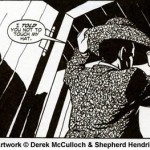

When Hauser (2009) describes how the Stagger Lee theme evolved between 1928 and the late 1950’s, he stresses that the hat has taken a much more prominent place. The hero is much less seen as a bad man, as a cruel killer, than as a man who justly fights about his Stetson hat. In this reasoning, the hat needs to have at the same time a positive and a negative meaning. It carries a negative symbolism when it stands for the white supremacy. At the same time however, it can also be seen as a positive symbol of the freedom that was won by challenging the Jim Crow system. It all depends on who wears the hat : the white man or the black man who wears it as a victory sign that he has survived the system and won his freedom by carrying a white man’s hat. In that context, he quotes findings that the hat was in certain times and places a prop that was very much wanted by African Americans who bought it on instalments. For them it was a symbol of freedom.
For a full understanding of Hauser’s thesis, it is essential here that I bring in the late 1950’s version that Lloyd Price brought eternal fame by his million seller version of Stagger Lee. Lloyd Price had during his time done in the Korean War included this song in his repertoire as band leader and had arranged a little play around the theme for the entertainment of his fellow soldiers. When returning from military duty, it was decided that the song would be the b-side of the single “You need love” (1958). In the beginning of the 50ties, it had already had a ‘swinging’ version brought by Archibald, so probably the record company didn’t risk to make it the a-side.
But the b-side became very quickly the favourite of the public; it was an overnight sensation : It was the first record by a black performer that reached number one of both the R&B and the pop charts. It was unprecedented, and this despite the resistance that it met with certain famous dj’s at the time who found it too violent.
In Lloyd Price’s version, Stagger Lee is no longer the villain, he is a pure hero who is put in the spotlights by swinging saxophones and a cheerful background choir. His version sounds like a celebration, it rocks and the enthusiasm is present in every note of it.
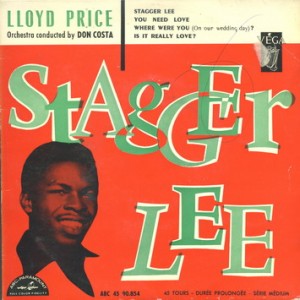
Why this change from a cautionary ballad to a swinging version that expresses joy?
It is argued that while the 1928 version helped the African American to survive in a system which he considers as invincible, the 1958 version testifies of the changed hopes of the black population. The Jim Crow system was no longer considered as definitive; events had happened which showed that it could be changed and that there was hope for demolishing discrimination. One such major event was Rosa Park’s refusal in 1955 to give up her seat in a bus to a white man and move to the back of the bus, as it was expected from a Negro. This was a act of deliberate badness, fully in the line with Stagger Lee’s act in 1895. Only, now in the fifties, the context had changed : the civil rights movement had seen the light which by acts of civil disobedience aimed at abolishing the discriminatory legal system.
The jubilant and enthusiastic tone that is heard in Price’s version can be interpreted as an expression of hope, as a song that new times were ahead and that on the horizon the freedom was starting to shine. In this context, the starting of the song in Price’s version is seen as essential : “The night was clear and the moon was yellow…And the leaves came tumbling down“. Then the horns start to blast. All this has without any doubt evoked in the minds of the African American population a reference to ancient spirituals, and more particularly to the bible story “Joshua Fit the Battle of Jericho” in which the “walls came tumbling down“. Joshua was for the African American a representation of how God could intervene to help the black slave population. It symbolized the fight against the slavery. Joshua was the God-chosen successor of Moses who was expected to lead his people of Israel to the promised land. It was not a big leap in the minds of the late 1950’s black population to hear in Price’s Stagger Lee the horns of freedom and to replace the ‘falling leaves’ with the “falling walls of segregation”.
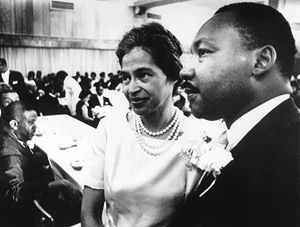
I will thus need to bring some differentiation in my earlier thesis that Stagger Lee helped to survive the Jim Crow system. It was more in particular the earlier version of the ballad that helped to cope with the system, and that was in this sense also functional in keeping the system intact. In the later version of the 1950’s, it would become a vehicle of hope that Jim Crow would at the end of the day be chased off.
I would like to end this post with the quote of an interesting thesis that Hauser develops on the Lloyd Price version of Stagger Lee. He considers it as the ultimate rock and roll song. I do not totally agree with his reasoning, but I find it deserves attention and discussion. In developing his argument he builds further upon the thematic scheme put forward by Herb Bowie in his book “Reason to Rock”, where a distinction is made between blues and jazz, with rock and roll in the middle of it. At the one hand, there is blues which has oppression has its major theme. For instance, when a blues artists sings about the pain that a woman causes him, he is in fact not singing about the woman but about the white race that causes him pain. At the other hand and opposite side there is jazz that by its basic characteristic of improvisation highlights the theme of freedom. Between blues and jazz, there is rock and roll, which puts liberation at the top of its music sheet, liberation for instance felt by the teenagers in the 1950’s from the shackles of the moral codes of their parents.
Considering that rock and roll, by the sideways of jump blues and rhythm and blues, developed into rock and roll, and considering that Stagger Lee was the major break through for black rock and roll, and considering that Lloyd Price’s version of Stagger Lee is the best expression of the the rock’s theme of liberation, the conclusion is no other than : Stagger Lee by Lloyd Price is the ultimate Rock and Roll song.
Is this not a challenging topic?
Sources :
– The Stagger Lee Files, James P. Hauser 2002-2009
– Simon Andrewes, The Stagger Lee Project, 2009
– Max Haymes, Got the blues for Mean Old Stack O’Lee, 2011
– Cecil Brown, Stagolee Shot Billy, 2003
